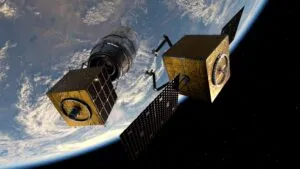Specifically it is the U.S. Patent No. 12,234,043 B2, “Method and System for Multi-Object Space Debris Removal”.
Under the patented method, the servicer docks with a debris object (the “client”) and transfers it to a reentry shepherd vehicle in a lower orbit.
Once the client is docked with the “shepherd”, says Astroscale, the servicer separates and proceeds to engage a new client. Meanwhile the shepherd guides the initial client into Earth’s atmosphere for reentry. This process can be repeated, allowing the servicer to remove multiple large debris objects over the course of a mission.
Distributed
“Our distributed architecture solves a key challenge in orbital debris removal by enabling the deorbit and reentry of multiple large debris objects sustainably and economically,” said Mike Lindsay, CTO at Astroscale.
“This approach allows us to reuse our advanced servicers, capable of capturing and detumbling multi-ton objects, instead of burning them up with the debris upon reentry. This not only saves cost but also reduces the amount of potentially harmful material released into the Earth’s upper atmosphere.”
According to the company, the patent builds on its approach used for the UK Space Agency-backed ELSA-M mission. This is due to launch in 2026.
This mission, however, will demonstrate removing several “prepared” inactive satellites in a single mission. That is to say, satellites including an external interface to enable their docking and removal.
The new patent method for active debris removal, by contrast, is for large, unprepared objects that were not built to be serviced. For example, rocket bodies and legacy satellites. These still require a safe, guided descent through the Earth’s atmosphere.
Orpheus
Recently, Astroscale UK won a £5.15 million satellite contract for the UK Space Agency’s Orpheus space domain awareness mission.
This aims to both characterise the ionosphere (the ionised portion of Earth’s upper atmosphere) and capture image data to support Space Domain Awareness. The space debris company is working with the UK Defence Science and Technology Laboratory (Dstl) to operate the mission.
The mission involves two CubeSat satellites – flying in formation in LEO – observing and collecting data using in-situ and remote sensing techniques.
Astroscale UK is a subsidiary of the Japan-based Astroscale.
Image: Astroscale
See also: Astroscale completes CDR for ELSA-M space debris removal mission

